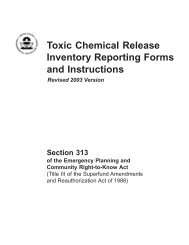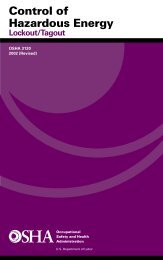Preventing Mold-Related Problems in the Indoor Workplace - Seton ...
Preventing Mold-Related Problems in the Indoor Workplace - Seton ...
Preventing Mold-Related Problems in the Indoor Workplace - Seton ...
You also want an ePaper? Increase the reach of your titles
YUMPU automatically turns print PDFs into web optimized ePapers that Google loves.
Appendix<br />
<strong>Mold</strong>s can cause three types of adverse health effects <strong>in</strong><br />
humans; allergy, <strong>in</strong>fection, and tox<strong>in</strong>-mediated conditions. These<br />
adverse health effects are discussed <strong>in</strong> more detail below.<br />
Allergy<br />
Allergic rh<strong>in</strong>itis<br />
Allergic rh<strong>in</strong>itis has several signs and symptoms. The symptoms<br />
of allergic rh<strong>in</strong>itis <strong>in</strong>clude sneez<strong>in</strong>g; itchy eyes, nose, and throat; a<br />
stuffy or runny nose; sore throat; cough; watery eyes; headache;<br />
and fatigue. These symptoms may be worse <strong>in</strong> <strong>in</strong>door environments<br />
and may peak <strong>in</strong> hot and humid seasons. Common physical<br />
f<strong>in</strong>d<strong>in</strong>gs <strong>in</strong>clude red or bloodshot eyes, a runny nose, watery<br />
eyes, and thickened nasal mucous membranes. Multiple airborne<br />
allergens o<strong>the</strong>r than molds (e.g., pollens, animal dander, and dust<br />
mites) may be <strong>in</strong>volved. However, when a person is also sensitized<br />
to mold, an <strong>in</strong>door environment contam<strong>in</strong>ated with mold spores<br />
may aggravate <strong>the</strong> signs and symptoms of allergic rh<strong>in</strong>itis (18).<br />
Allergic asthma<br />
Allergic asthma is a chronic lung disease that is caused by<br />
breath<strong>in</strong>g <strong>in</strong> substances known to be allergens (sensitizers).<br />
Asthma occurs when <strong>the</strong> airways become <strong>in</strong>flamed and <strong>the</strong><br />
surround<strong>in</strong>g muscles tighten and contract. Asthma causes<br />
breath<strong>in</strong>g difficulties by mak<strong>in</strong>g it harder for air to flow <strong>in</strong> and out<br />
of <strong>the</strong> lungs. Symptoms of asthma <strong>in</strong>clude tightness of <strong>the</strong> chest,<br />
shortness of breath, cough<strong>in</strong>g, and wheez<strong>in</strong>g (21). Although a<br />
complete patient history and physical exam are <strong>the</strong> most important<br />
methods employed to diagnose asthma, chest X-rays, pulmonary<br />
function test<strong>in</strong>g, and immunologic studies occasionally are also<br />
used.<br />
Exposure to mold clearly plays a role <strong>in</strong> asthma. <strong>Mold</strong>s produce<br />
a large variety of compounds that are potentially allergenic (e.g.,<br />
prote<strong>in</strong>s). Potency varies among <strong>the</strong>se allergens. The epidemi-<br />
18
















